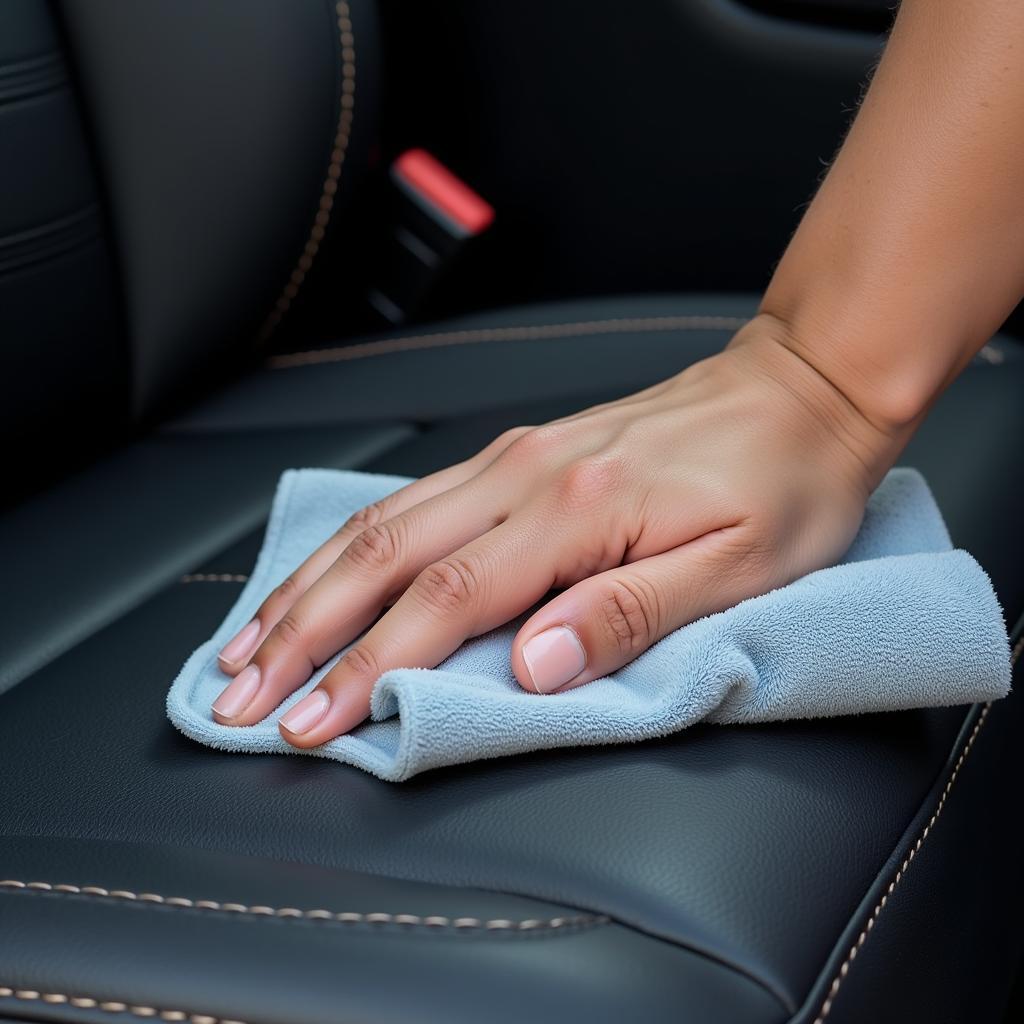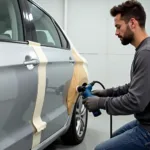Leather car seats add a touch of luxury and sophistication to any vehicle. However, they are susceptible to wear and tear, requiring proper care and occasional repair. Knowing how to repair leather car seats can save you a significant amount of money compared to professional reupholstering or replacement. This guide will equip you with the knowledge and techniques to tackle various types of leather car seat damage.
Leather is a natural material, and like our skin, it needs regular conditioning to stay supple and resilient. Neglecting this can lead to cracking, fading, and other damage. This guide covers everything from minor scratches and scuffs to more significant damage like burns and tears. We’ll discuss the necessary tools, materials, and step-by-step procedures to bring your leather car seats back to life. You’ll also learn how to distinguish between different types of leather and the appropriate repair methods for each.
Choosing the right repair kit is crucial. Opt for a high-quality kit specifically designed for automotive leather. These kits usually contain a color-matched filler, adhesive, and various applicators. You can find these at most auto parts stores or online. Remember, prevention is key. Regularly cleaning and conditioning your leather seats will significantly reduce the likelihood of damage and keep them looking their best for years to come. Want to know more about dealing with those pesky scratches? Check out our guide on how to repair leather scratches in car seat.
Identifying the Type of Damage
Before you begin any repair, it’s crucial to identify the type of damage your leather car seats have sustained. This will determine the appropriate repair method and materials.
Scratches and Scuffs
Superficial scratches and scuffs are the most common type of damage and can often be addressed with simple cleaning and conditioning. Deeper scratches may require a leather filler.
Cracks and Tears
Cracks and tears require more extensive repair. A leather repair kit containing a patching material and adhesive is typically necessary. For severe tears, professional repair might be the best option.
Burns
Cigarette burns or other small burns can often be repaired using a leather filler and color-matching techniques.
Stains and Discoloration
Stains and discoloration can sometimes be removed with specialized leather cleaners. However, stubborn stains might require professional attention.
How to Repair Minor Scratches and Scuffs
Minor scratches and scuffs can often be remedied with a simple cleaning and conditioning routine. First, clean the affected area with a dedicated leather cleaner and a microfiber cloth. Then, apply a leather conditioner to restore the leather’s suppleness and minimize the appearance of the scratch.
- Clean the area: Use a damp microfiber cloth and leather cleaner.
- Apply conditioner: Massage a small amount of leather conditioner onto the affected area.
- Buff the surface: Use a clean microfiber cloth to buff the area and restore its shine.
How to Repair Deeper Scratches and Tears
Deeper scratches and tears require a more involved approach. You’ll need a leather repair kit that contains a filler, adhesive, and color-matching pigments. If you’re dealing with wrinkled leather, we have a specific guide for that: how to repair wrinkled leather car seats.
- Clean the area: Thoroughly clean the damaged area with a leather cleaner.
- Apply filler: Fill the scratch or tear with the leather filler, ensuring it’s level with the surrounding surface.
- Sand and smooth: Once dry, gently sand the filler to create a smooth, even surface.
- Apply colorant: Use the color-matching pigments to blend the repair with the original leather color.
- Seal the repair: Apply a leather sealant to protect the repair and restore the leather’s finish.
Dealing with scuffed leather? Our guide on how do you repair scuffed leather car seats provides detailed instructions.
How to Repair Burns in Leather Car Seats
Burns require a similar approach to repairing deep scratches. Check out our guide on how to repair a cigarette burn in leather car seats for a detailed walkthrough. You’ll need a leather repair kit and patience for this repair.
- Clean the area: Gently clean the burned area.
- Remove charred material: Carefully remove any loose, charred material with tweezers.
- Apply filler: Fill the burn with leather filler, building it up gradually.
- Sand and smooth: Once dry, sand the filler to blend it seamlessly with the surrounding leather.
- Apply colorant: Use color-matching pigments to match the original leather color.
- Seal the repair: Apply a leather sealant to protect the repaired area.
Conclusion: Maintaining Your Leather Car Seats
Knowing how to repair leather car seats can significantly extend their lifespan and maintain the interior’s pristine appearance. Regular cleaning and conditioning are essential for preventing damage and keeping your leather looking its best. For worn black leather, check out our guide: how to repair worn black leather car seats. Remember, prompt attention to any damage will prevent it from worsening and ensure a successful repair.
FAQ
- What is the best way to clean leather car seats? Use a dedicated leather cleaner and a microfiber cloth.
- How often should I condition my leather car seats? Every 3-6 months, or more frequently in harsh climates.
- Can I repair a tear in my leather car seat myself? Yes, minor tears can be repaired with a leather repair kit.
- What should I do if my leather car seat is stained? Try a specialized leather cleaner. For stubborn stains, consult a professional.
- What type of leather cleaner should I use? Use a pH-neutral cleaner specifically designed for automotive leather.
- How can I prevent my leather car seats from cracking? Regular cleaning and conditioning are key.
- Where can I find a leather repair kit? Most auto parts stores and online retailers sell them.
Need more help? Contact us via WhatsApp: +1(641)206-8880 or Email: [email protected]. Our 24/7 customer support team is ready to assist you.



